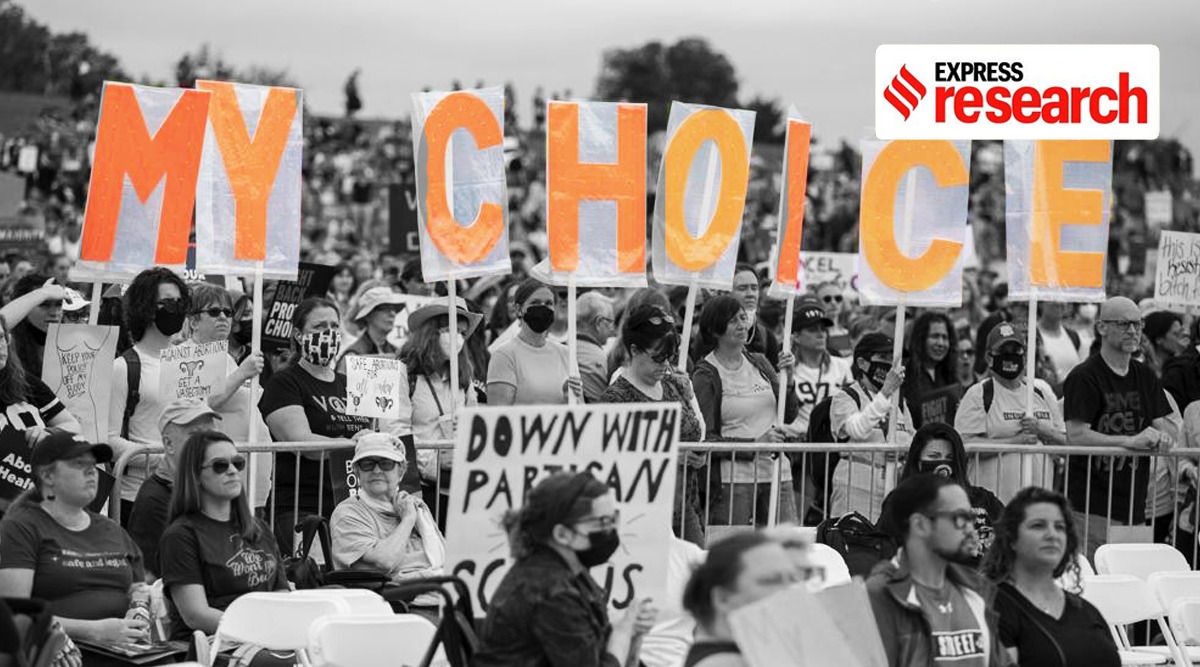Earlier this month, a leaked Supreme Court draft opinion sent shockwaves across the United States when it revealed that the nation’s highest court planned to overturn Roe v Wade, a landmark judgment that protects a pregnant woman’s liberty to have an abortion without excessive government restriction.
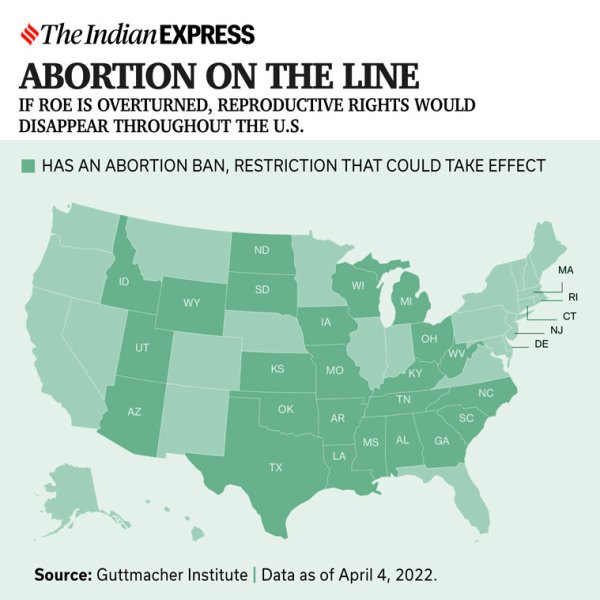 States that may overturn abortion access (Indian Express)
States that may overturn abortion access (Indian Express)
Although it is still unclear whether the judgment may change, if it stands, individual states would be able to decide whether or not abortions would be legal under their jurisdiction. According to the Guttmacher Institute, which collects data on abortion policies, if Roe is repealed, abortion would almost certainly become illegal or heavily restricted in 22 states and would be under severe threat in at least four others.

In response to the details of this leak, Amnesty International’s Secretary General said that “any regression in protection of the right to abortion would not only stand to damage the global perception of the United States; it would also set a terrible example that other governments and anti-rights groups could seize upon around the world.”
The parameters underlying abortion policy in most countries deal with gestational limits and the conditions under which women are permitted to access abortions legally. While some two dozen countries do ban abortion altogether, in most, abortion is legal under certain circumstances.
Global abortion rights
According to a report from the Council on Foreign Relations, the past 50 years have been defined by “an unmistakable trend towards liberalisation of abortion laws, particularly in the industrialised world.”
Since 2000, 38 countries have changed their abortion laws to allow for more access.
Today, 73 countries make abortion available at the pregnant women’s request with European nations like the Netherlands and Norway leading the pack. However, in the majority of developing nations, abortion access lags far behind. Poor countries usually lack proper family planning, high rates of child marriage, more instances of violence such as rape, and inadequate medical systems. For women living there, medical abortions are often their only hope.
Since the 1970s, women have been able to take a cheap stomach ulcer drug known as misoprostol to end their pregnancies within 11 weeks of conception. Taken along with mifepristone, the drug combination is known as a medical abortion. Research from the Guttmacher Institute shows that in 2020, medical abortion accounted for more than half of all abortions in the US.
Medical abortions are much safer and that, combined with advancements in technology could explain why since 1992, the treatment rate for severe complications from abortion has declined by 76 per cent. In Latin America as a whole, the rate of complications declined by a third since 2005, despite the rate of abortions increasing over that time period. Since the early nineties, abortion related deaths have declined by 42 per cent globally.
Abortion rights in India
According to a study published in the Lancet Global Health Journal, 15.6 million abortions took place in India in 2015. Of these, 22 per cent took place in health facilities, 73 per cent were done through medical methods outside of facilities and 5 per cent were done through other methods. Vinod Manning, Director of ISPAS, a non profit that deals with women’s reproductive rights, told indianexpress.com that the debate over abortion in the US could impact India as well. He said that “in India, the abortion law has been recently amended and while it is still not perfect, it is an advancement – this is one of the worst times for us to open the debate on abortion or not – potentially triggered by the developments in the US, that will be a big setback.”
Before the passing of the Medical Termination of Pregnancy (MTP) act in 1971, abortions were criminalised under the Indian Penal Code. The MTP changed that but still imposed heavy restrictions, especially pertaining to unmarried women. In its current iteration, the 2021 MTP act allows abortion in a number of circumstances, most pertaining to the health and safety of the woman.
The law allows abortion during the first 20 weeks with approval from a medical practitioner and from the 20 to 24 weeks with authorisation by two medical practitioners. In cases involving a severe foetal anomaly after the 24-week mark, a three-person medical board must confirm the diagnosis with the final decision resting with a judge.

The last scenario is uncommon but given that serious medical problems can’t always be detected in under 20 weeks, it is one for which the consequence of getting it wrong is quite significant. In rural Maharashtra, studies found that only 3 per cent of abortions took place after the 20-week period, which is also the legal benchmark adopted by most countries. However, activists warn that restricting legal abortions to 20 weeks’ gestation may deny women the time they need to make an informed decision. Additionally, foetal abnormalities are frequently undetectable before 20 weeks.
Although India was one of the first countries to adopt legislation allowing abortion, obstacles to access still remain. According to a report published by the Center for Reproductive Rights, “legal and practical barriers are a serious impediment” with unsafe abortions in India accounting for 20 per cent of all maternal deaths, a percentage similar to the incidence in countries where abortion is banned.
The report states that there is a lack of registered healthcare providers trained to perform an abortion, a lack of facilities equipped to perform the procedure, a prevalence of social stigma surrounding the practice and frequent cases of contradictory judgements from the courts. This disproportionately affects poor women, who do not have adequate medical resources and may be uninformed about their rights.
A study focusing on the economic profiles of women seeking abortion in Madhya Pradesh revealed that 57 per cent of women who received abortion care in public facilities were poor, and 21 per cent were middle class. Despite that, the Abortion Assessment Project of India Report found that, of the abortion facilities surveyed, public sector facilities accounted for only one fourth of the total. Private services are far more common and effective, but beyond the economic reach of most of the country.
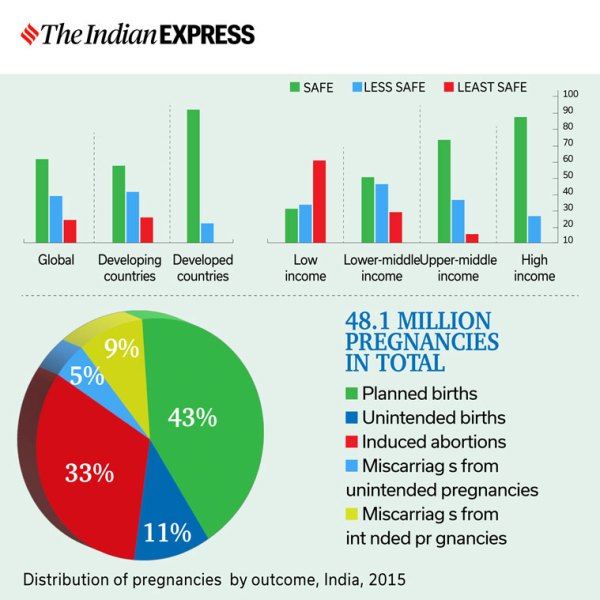
State of abortion access
Access to safe abortions has been established as a human right by a number of frameworks, the United Nations, the European Court of Human Rights and the African Commission on Human and People’s Rights. In 1994, at the International Conference on Population and Development, 179 governments signed a commitment to prevent unsafe abortions.
The UN asserts that the criminalisation of abortion is recognised as a form of “gender-based violence that, depending on the circumstances, may amount to torture or cruel, inhuman or degrading treatment and also violate women’s rights to health, dignity, autonomy, and equality.” It also claims that when women are denied abortions due to restrictive laws, this constitutes a violation of the state’s obligations to prevent and prohibit forced pregnancy.
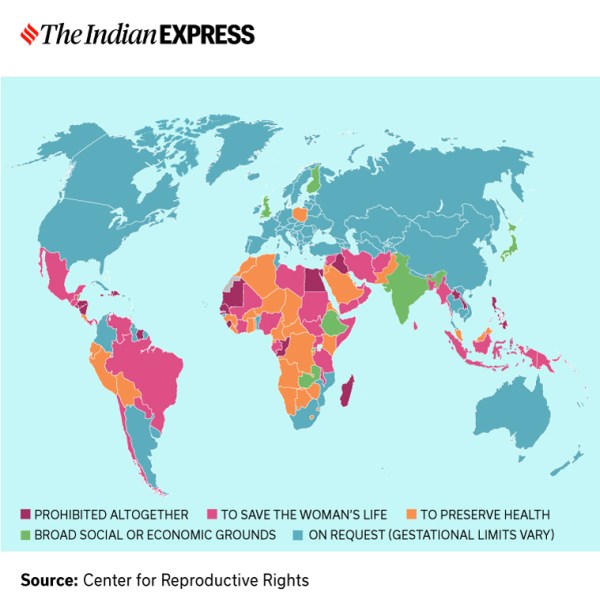 Abortion access globally (Indian Express)
Abortion access globally (Indian Express)
However, it’s important to remember that even when abortions are legal, they may not always be safe. To determine safety, the WHO has classified abortion procedures into three categories, namely, safe, less-safe and least-safe. According to the Lancet study, of the approximately 55.7 million abortions that occurred per year from 2010 to 2014, 54 per cent were safe, 30 per cent were less safe and 14 per cent were least safe. The developing world accounted for more than 97 per cent of abortions classified under the latter two categories.
The WHO asserts that unsafe abortions are the leading cause of maternal death, with 13 per cent of them attributed to the procedure. In developing countries alone, 7 million women were treated in hospital for complications arising from unsafe abortions in 2012.
According to the World Population review, women in developing nations are more likely to experience unplanned pregnancies due to lack of birth control and sexual education, along with higher occurrences of sexual assault. After experiencing an unwanted pregnancy, they then lack access to safe abortions, which accounts for the disparity between the global rich and global poor.
Estimates from 2006 show that complications from unsafe abortions cost health systems in developing countries $553 million per year and resulted in a loss of household income amounting to $922 million.
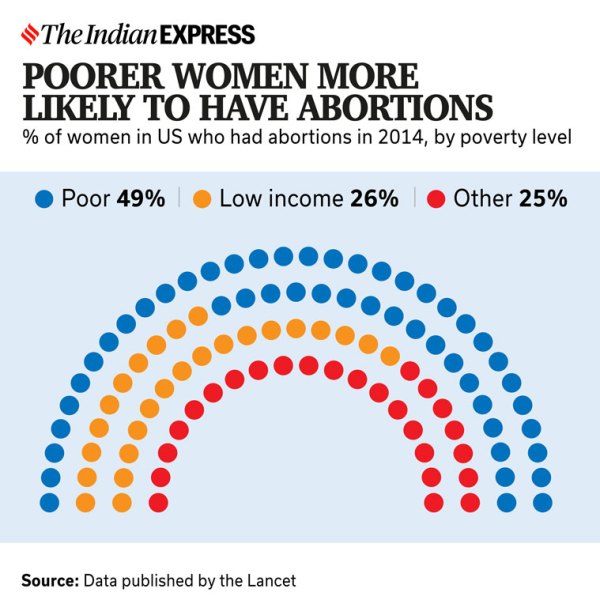
However, even in developed countries, problems remain. The Brookings Institute estimates that in America, a poor woman is five times as likely as an affluent woman to have an unintended birth, which “further deepens the divides in income, family stability, and child outcomes.” The Guttmacher Institute found that 49 per cent of abortion patients in America are living below the poverty line. And, according to another Brookings report, restricting abortion access in countries like America would “diminish women’s personal and economic lives as well as the lives of their families,” particularly in cases involving poor women.
A combination of these factors point to a chilling reality if abortion rights are scaled back. Women are forced to make the difficult choice of either carrying to term a pregnancy they cannot afford or do not want, or submit themselves to a potentially dangerous procedure performed outside of registered medical facilities.
Political debate around abortion
There is extreme polarisation in the debate over abortion access with points of controversy largely pertaining to the ‘slippery slope’ argument, the question of when life begins, and medical risks for pregnant women. There is also a less prevalent argument that abortion leads to eugenics, in which a pregnant women may choose to abort her child if the child is a girl or is likely to be born with significant disabilities.
Addressing the ‘slippery slope argument,’ anti-abortion activists claim that when abortion is legalised, it becomes far more prevalent. In 1999, a team of economists estimated that states legalising abortion had to a 4 to 11 per cent decline in births relative to the rest of the US. However, they also state that this fertility decline was largely associated with young and impoverished mothers who experienced birth rate reductions nearly three times greater than the overall population.
Similarly, CK Meyers, a researcher at Middlebury University, found that legalised abortions reduced the number of women who became teen mothers by 34 per cent and the number who became teen brides by 20 per cent.
Additionally, research indicates that the foundation of the claim (that legalised abortions equal more abortions) is untrue on a global level. According to the WHO, countries that have criminalised abortions tend to have a much higher abortion rate than countries in which it is legal. Although it is worth mentioning that the disparity is also due to a higher number of unintended pregnancies in developing nations.
According to Daniel Mishell, a professor at the University of Southern California, banning abortion will not stop the practice as before it was legalised, women would try to induce abortions using back ally techniques. Essentially, whether it’s legal or not, women will continue to seek ways to terminate pregnancies.
Additionally, while legalising abortion may lead to more abortions in counties like the US, it would also lead to an increase in safe practices. And in developing countries, a higher rate of abortions would be mitigated if legalisation was accompanied by better family planning policies.
The next argument, which is frequently employed by religious leaders, pertains to when the foetus begins showing signs of life. The Catholic Church believes that life begins at conception and therefore all abortions amount to murder. Their view is considerably more extreme than that of other religions. In Hinduism, actions are chosen on the basis of harm and if an abortion is required to save a mothers life, it is tolerated by Hindu doctrine. Islam, Jainism and Buddhism follow a similar line of thought.
The reason why this is such a point of contention is partially because the medical community is yet to form a consensus on when life begins. According to a report in the Los Angeles Law Review, some physicians believe that abortion should be permitted with impunity at any time up to the sixth month of pregnancy whereas others believe life begins at conception and cite the Hippocratic oath’s tenet to do no harm as their reason for opposing the practice.
It is also worth considering the right to life against the right to a dignified life. Unwanted babies are more likely to be neglected, abused or stuck in cycles of poverty according to the WHO.
Lastly, people argue that abortions can damage the physical and psychological health of women. A study published in the Scandinavian Journal of Public Health found that young adult women who undergo abortions “may be at risk for subsequent depression.” A study in BMC Medicine concurs with that view, asserting that women who underwent an abortion had “significantly higher” anxiety scores than women who didn’t. Additionally, the International Journal of Epidemiology published a
that estimated that 15 per cent of first-trimester miscarriages are attributed to a prior history of induced abortions.
Most Read 1Chandrayaan-3 mission: Dawn breaks on Moon, all eyes on lander, rover to wake up 2As Indo-Canadian relations sour, anxiety grips Indian students, residents who wish to settle in Canada 3Karan Johar says Sanjay Leela Bhansali did not call him after Rocky Aur Rani: ‘He’s never called me but…’ 4Gadar 2 box office collection day 40: Hit by Shah Rukh Khan’s Jawan onslaught, Sunny Deol movie ends BO run with Rs 45 lakh earning 5Shubh’s tour in India cancelled: Why is the Canada-based singer facing the music?
However, another study found that 95 per cent of women who received abortions felt like it was the right decision a week after the procedure. Reports from the American Psychological Association and John Hopkins School of Public Health also concluded that links between abortions and mental health problems were unsubstantiated.
From a medical perspective, a study published by Obstetrics and Gynaecology reported that less than one quarter of one percent of abortions in the US led to major health complications. It also found that a woman’s risk of dying from an abortion is 0.6 in 100,000 while the risk of dying from giving birth is 14 times higher.
Also ReadHow Lord Ganesha is celebrated outside IndiaKashmir when India got independence: Neither here nor thereHow Thakurs have dominated UP politics since IndependenceHere is what happened in Kedarnath, and rest of Uttarakhand, in 2013
While the question of whether or not to legalise abortion will always be a contested and sensitive one, there are a number of takeaways that could influence policy like the need to provide comprehensive family planning services and adequate support for women who experience unintended births.


